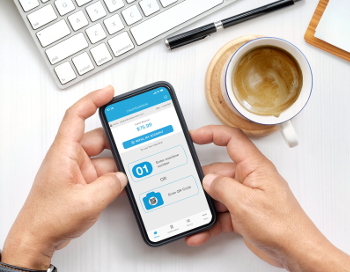A virtual penny for your thoughts
Converting to Cashless

As if we needed yet another example of how Covid-19 changed our society, think about money for a moment. When the pandemic hit, the first thing we gave up was shaking hands and hugging. Then we didn’t want to touch anything someone else might have touched.
At the same time, due to lockdowns and the mints not working at full capacity, there was a coin shortage. Banks were putting out appeals for people to empty those piggy banks they’d been thoughtlessly filling for years.
Suddenly, the cashless society took a giant leap forward. After all, who knows where those coins and bills have been?
The growing consumer demand for cashless
Credit card and debit card transactions have been increasing each year since they were introduced. But some aspects of our industry, notably the coin laundries, have still leaned heavily on actual currency to operate. This dependence brought with it some problems, though.
- Customers needed coins, so operators had to have staff on duty, or bill changing machines, to make it possible for people to use their equipment.
- All that coinage in one place became a magnet for thieves.
- Handling coins, banking coins, and otherwise dealing with actual money, is not just a hassle, it’s heavy and prone to errors.
When coin laundries began dispensing tokens, and then moved to full-on cashless systems, consumers liked it. It was easy, and less time-consuming than scrambling under the couch cushions for change, and very accurate. A credit card transaction doesn’t jam the machine like coin sliders can. And laundry owners got a nice print-out of their transactions at the end of the month, with money going directly into their account.
Back to the Future
Today’s cashless systems are not only more efficient, they have new features never dreamed of by the original laundry owners. They can also be retrofitted to existing equipment.

We asked Don Neufeld, VP of Sales for Coinamatic Commercial Laundry and Coinamatic Canada Inc. (CCL), what trends he’s seen in the cashless arena in the last few years.
“We have definitely experienced an uptick in demand for cashless systems,” he said. “This trend has been happening for a few years but definitely accelerated during the pandemic. [During Covid] consumers transitioned to debit and credit payments for almost everything and ceased using cash.”
Features of cashless systems

“CCL provides a cashless system that allows for consumers to pay for and start the laundry equipment using a debit card, credit card, Apple Pay or Google Pay right at the machine level. The system uses an Ultra LX reader that is easily installed, user-friendly and, with a tap, consumers can pay for their laundry.
“With this system, store owners get unique access to a Retail Washboard, which includes critical financial data and service information that provides an overview of usage and laundromat performance.”
Things to think about
“Laundromats typically have a wide range of equipment, both small chassis and multi-load, that they have purchased over time,” said Neufeld. “This means there can be different models, sizes and ages of equipment all in a single location. It’s important to work closely with the supplier to ensure the equipment can be easily retrofitted for an electronic payment system. For most newer models, this will not be an issue. It can also be a great time to update older equipment to get the features of the newer models.
“The laundry owner needs to understand the ongoing and recurring costs of adding cashless equipment. They also should have a great understanding of their current equipment. Consumer demand is moving in the direction of cashless machines, so this is an investment in the future of the store.”
The cost to go cashless

“Transitioning from coin to cashless does involve some set-up costs. First, the facility must have good internet access, since the machines must communicate with the transaction processor. This can be achieved with a hard-wired IP line or a cellular modem with Wi-Fi.
“Each machine will require the appropriate reader,” Neufeld continued, “and the store owner must be set up with the financial processor that is associated with the payment equipment. There will be initial set-up fees as well as interchange and per-transaction fees. These fees are determined by the financial processor, and total transactions rates can range from 3.5% to 4%.”
It might be intimidating to try to understand all the electronic and virtual ins and outs of a cashless system, but a good supplier will be your strong right hand in the transition. They should be able to clearly explain exactly what you need, how it all goes together, and get you set up to receive cashless transactions like a pro.
How many of your competitors are cashless? If some are, you need to catch up in order to keep your customers happy. If none are, think what a great marketing distinctive this can be. Either way, communicating the changes in an upbeat manner will be key to customer acceptance.
If you make the change (pun intended), let us know how it goes. Maybe we can profile your journey for our readers.
You can read a case study of one laundry owner who went cashless in Quebec on the Coinamatic website.






